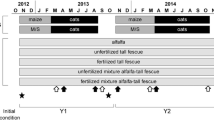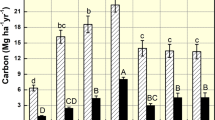Abstract
Background and aims
In agroecosystems, carbon (C) inputs come from plant roots, retained shoot residues and in some cases from applied manures. Manure and shoot derived C inputs are relatively easy to determine. Conversely, high costs associated with root measurements have caused knowledge on root C input to remain scant. This study aimed at determining macro-root C input and topsoil root related respiration in response to nutrient management and soil fertility building measures.
Methods
We sampled roots and shoots of cereals and catch crops in inorganic and organic fertilizer-based arable cropping systems in a long-term experiment in 2 years, 2008 and 2010. Sampled shoots and macro-roots of catch crop mixtures and cereals were characterized for dry matter (DM) biomass (C was estimated as 45 % of DM biomass). We also measured topsoil root-related soil respiration throughout the growing season of winter wheat by subtracting soil respiration from soil with and without exclusion of roots.
Results
Catch crop roots accounted for more than 40 % of total plant C. For spring barley in 2008 and spring wheat in 2010, root C was higher in the organic than in the inorganic fertilizer-based systems. However, for winter wheat in 2008 and spring barley in 2010, there were similar amounts of root C across systems. The measurements of topsoil root-derived respiration also showed no difference across systems, despite large differences in harvested cereal yields. Cereal biomass shoot-to-root (S/R) ratio was higher (31–131 %) in inorganic than in organic fertilizer-based systems.
Conclusions
Our findings show that macro-roots of both cereal crops and catch crops play a relatively larger role in organically managed systems than in mineral fertilizer based systems; and that the use of fixed biomass S/R ratios to estimate root biomass leads to erroneous estimates of root C input.

Similar content being viewed by others
References
Amthor JS (2000) Plant respiratory responses to the environment and their effects on the carbon balance. In: Wilkinson RE (ed) Plant-environment interactions. Marcel Dekker, New York, pp 501–504
Askegaard M, Olesen JE, Rasmussen IA, Kristensen K (2011) Nitrate leaching from organic arable crop rotations is mostly determined by autumn field management. Agric Ecosyst Environ 142:149–160
Barraclough PB (1984) The growth and activity of winter wheat roots in the field: root growth of high-yielding crops in relation to shoot growth. J Agric Sci 103:439–442
Barraclough PB, Leigh RA (1984) The growth and activity of winter wheat roots in the field: the effect of sowing date and soil type on root growth of high-yielding crops. J Agric Sci 103:59–74
Berry PM, Sylvester-Bradley R, Philipps L, Hatch DJ, Cuttle SP, Rayans FW, Gosling P (2002) Is the productivity of organic farms restricted by the supply of available nitrogen. Soil Use Manag 18:248–255
Bolinder MA, Angers DA, Dubuc JP (1997) Estimating shoot to root ratios and annual carbon inputs in soils for cereal crops. Agric Ecosyst Environ 63:61–66
Bolinder MA, Angers DA, Bélanger G, Michaud R, Laverdiére MR (2002) Root biomass and shoot to root ratios of perennial forage crops in eastern Canada. Can J Plant Sci 82:731–737
Brown SC, Keatinge JDH, Gregory PJ, Cooper PJM (1987) Effects of fertilizer, variety and location on barley production under rainfed conditions in northern Syria. 1. Root and shoot growth. Field Crop Res 16:53–66
Campbell CA, de Jong R (2001) Root-to-straw ratios influence of moisture and rate of N fertilizer. Can J Soil Sci 81:39–43
Cheng W, Johnson DW, Fu S (2003) Rhizosphere effects on decomposition: control of plant species, phenology, and fertilization. Soil Sci Soc Am J 67:1418–1427
Chirinda N, Olesen JE, Porter JR, Schjønning P (2010) Soil properties, crop production and greenhouse gas emissions from organic and inorganic fertilizer-based arable cropping systems. Agric Ecosyst Environ 139:584–594
Chirinda N, Kracher D, Lægdsmand M, Porter JR, Olesen JE, Petersen BM, Doltra J, Kiese R, Butterbach-Bahl K (2011) Simulating soil N2O emissions and heterotrophic CO2 respiration in arable systems using FASSET and MoBiLE-DNDC. Plant Soil 343:139–160
Christensen BT, Johnston AE (1997) Soil organic matter and soil quality: Lessons learned from long-term field experiments at Askov and Rothamsted. In: Gregorich EG, Carter MR (eds) Soil quality for crop production and ecosystem health. Elsevier, Amsterdam, pp 399–430
Clark LJ, Whalley WR, Barraclough PB (2003) How do roots penetrate strong soil? Plant Soil 255:93–104
Craft CB, Seneca ED, Broome SW (1991) Loss on ignition and Kjeldahl digestion for estimating organic carbon and total nitrogen in estuarine marsh soils: calibration with dry combustion. Estuaries 14:175–179
Djurhuus J, Olesen JE (2000) Characterisation of four sites in Denmark for long-term experiments on crop rotations for organic farming. DIAS Report Plant Production No. 33
Dobbie KE, McTaggart IP, Smith KA (1999) Nitrous oxide emissions from intensive agricultural systems: variations between crops and seasons, key driving variables, and mean emission factors. J Geophys Res 104:26891–26899
Dupuy L, Gregory PJ, Bengough AG (2010) Root growth models. Towards a new generation of continuous approaches. J Exp Bot 61:2131–2143
Fustec J, Lesuffleur F, Mahieu S, Cliquet J-B (2010) Nitrogen rhizodeposition of legumes. A review. Agron Sustain Dev 30:57–66
Gough CM, Seiler JR (2004) The influence of environmental, soil carbon, root, and stand characteristics on soil CO2 efflux in loblolly pine (Pinus taeda L.) plantations located on the South Carolina Coastal plain. For Ecol Manag 191:353–363
Gregory P (2006) Plant roots: Growth, activity and interaction with soils. Blackwell Publishing ISBN 978-1-4051-1906-1
Gyldenkærne S, Petersen BM, Olesen JE (2007) Konsekvenser og muligheder ved Danmarks deltagelse i Kyoto-protokollens artikel 3.4 på landbrugsområdet (Consequences and possibilities in participation of Denmark in the Kyoto Protocol article 3.4 within agriculture). Working Report from Environmental Protection Agency 5/2007. Ministry of Environment, Copenhagen
Hansen B (1989) Determination of nitrogen as elementary N, an alternative to Kjeldahl. Acta Agric Scand B-S P 39:113–118
Heinemeyer A, Hartley IP, Evans SP, Carreira de la Fuente JA, Ineson P (2007) Forest soil CO2 flux: uncovering the contribution and environmental responses of ectomycorrhizas. Global Change Biol 13:1786–1797
Hilbert DW (1990) Optimization of plant root:shoot ratios and internal N concentration. Ann Bot 66:91–99
Hodge A (2004) The plastic plant: root responses to heterogeneous supplies of nutrients. New Phytol 162:9–24
Hodge A, Stewart J, Robinson D et al (2000) Competition between roots and soil micro-organisms for nutrients from nitrogen-rich patches of varying complexity. J Ecol 88:150–164
Jimenez MA, Schmid H, von Lützow M, Guster R, Munch JC (2002) Evidence for recycling of N from plants to soil during the growing season. Geoderma 105:223–241
Johnson JMF, Allmaras RR, Reicosky DC (2006) Estimating source carbon from crop residues roots and rhizodeposits using the national grain-yield database. Agron J 98:622–636
Kalra YP, Maynard DG (1991) Methods manual for forest soil and plant analysis. Informations Report NOR-X-319. Northwest Region, Canada
Kang JG, van Iersel MW (2004) Nutrient solution concentration affects shoot:root ratio, leaf area ratio, and growth of subirrigated Salvia (Salvia splendens). HortSci 39:49–54
Kätterer T, Bolinder MA, Andrén O, Kirchmann H, Menichetti L (2011) Roots contribute more to refractory soil organic matter than above-ground crop residues, as reveled by a long-term field experiment. Agric Ecosyst Environ 141:184–192
Kong AYY, Six J (2010) Tracing root vs. residue carbon in soils from conventional and alternative cropping systems. Soil Sci Soc Am J 74:1201–1210
Kuzyakov Y, Cheng W (2001) Photosynthesis controls of rhizosphere respiration and organic matter decomposition. Soil Biol Biochem 33:1915–1925
Kuzyakov Y, Domanski G (2000) Carbon input by plants into the soil. Review. J Plant Nutri Soil Sci 163:421–431
Kuzyakov Y, Schneckenberger K (2004) Review of estimation of plant rhizodeposition and their contribution to soil organic matter formation. Arch Agron Soil Sci 50:115–132
Liu H, Li F (2005) Photosynthesis, root respiration, and grain yield of spring wheat in response to surface soil drying. Plant Growth Regul 45:149–154
Luo Y, Zhou X (2006) Soil respiration and the environment. Academic press, Elsevier, ISBN 978-0-12-088782-8
Möller K (2009) Inner farm nutrient flows between arable land and permanent grassland via the stable in organic cropping systems. Eur J Agron 31:204–212
Muñoz-Romero V, Benítez-Vega J, López-Bellido RJ, Fontán JM, López-Bellido L (2009) Effect of tillage system on the root growth of spring wheat. Plant Soil 326:97–107
Olesen JE, Askegaard M, Rasmussen IA (2000) Design of an organic farming crop-rotation experiment. Acta Agric Scand B-S P 50:13–21
Olesen JE, Hansen EM, Askegaard M, Rasmussen IA (2007) The value of catch crops and organic manures for spring barley in organic arable farming. Field Crop Res 100:168–178
Olesen JE, Askegaard M, Rasmussen IA (2009) Winter cereal yields as affected by animal manure and green manure in organic arable farming. Eur J Agron 30:119–128
Oliveira MG, van Noordwijk M, Gaze SR, Brouwer SB, Mosca G, Hairiah K (2000) Auger sampling, ingrowth cores and pinboard methods In: Smit AL, Bengough AG, Engels C et al (eds) Root methods: A handbook. Springer, ISBN 3-540-66728-8, p 205
Plantedirektoratet (1994) Fælles arbejdsmetoder for jordbundsanalyser. Plantedirektoratet, Copenhagen
Porter JR, Klepper B, Belford RK (1986) A model (WHTROOT) which synchronizes root growth and development with shoot development for winter wheat. Plant Soil 92:133–145
Qian P, Schoenau JJ, Huang WZ (1992) Use of ion exchange membranes in routine soil testing. Commun Soil Sci Plant Anal 23:1791–1804
Rasse DP, Rumpel C, Dignac M (2005) Is soil carbon mostly root carbon? Mechanisms for a specific stabilization. Plant Soil 269:341–356
Rice WR (1989) Analyzing tables of statistical tests. Evolution 43:223–225
Ryan PR, Delhaize E, Jones DL (2001) Function and mechanism of organic anion exudation from plant roots. Annu Rev Plant Phys 52:527–560
Sanaullah M, Chabbi A, Leifeld J, Bardoux G, Billou D, Rumpel C (2011) Decomposition and stabilization of root litter in top- and subsoil horizons: what is the difference? Plant Soil 338:127–141
SAS Institute (1996) SAS/STAT™ Software: changes and enhancements through release 6.11. SAS Institute, Cary
Schjønning P, de Jonge LW, Munkholm LJ, Moldrup P, Christensen BT, Olesen JE (2012) Drivers for dispersibility and soil friability – test of the clay carbon saturation concept. Vadose Zone J (in press)
Subedi KD, Ma BL, Liang BC (2006) New method to estimate root biomass in soil through root-derived carbon. Soil Biol Biochem 38:2212–2218
Swinnen J (1994) Rhizodeposition and turnover of root-derived organic material in barley and wheat under conventional and integrated management. Agric Ecosyst Environ 51:115–128
Swinnen J, Van Veen JA, Merckx R (1995) Carbon fluxes in the rhizosphere of winter wheat and spring barley with conventional vs. integrated farming. Soil Biol Biochem 27:811–820
Tarmi S, Helenius J, Hyvönen T (2009) Importance of edaphic, spatial and management factors for plant communities of field boundaries. Agric Ecosyst Environ 131:201–206
Thomsen IK, Christensen BT (2004) Yields of wheat and soil carbon and nitrogen contents following long-term incorporation of barley straw and ryegrass catch crops. Soil Use Manag 20:432–438
Thomsen IK, Olesen JE (2000) C and N mineralization of composted and anaerobically stored ruminant manure in differently textured soils. J Agric Sci 135:151–159
van Noordwijk M, Brouwer G, Koning H, Meijboom FW, Grzebisz W (1994) Production and decay of structural root material of winter wheat and sugar beet in conventional and integrated cropping systems. Agric Ecosyst Environ 51:99–113
Acknowledgments
The authors gratefully acknowledge the support of the International Centre for Research in Organic Food Systems (ICROFS) and NitroEurope (NEU) for support. The work was part of the CROPSYS project funded by the Danish Ministry of Food, Agriculture and Fisheries. We thank Dr. Kristian Kristensen for advice on the statistical analyses and Erling E. Nielsen, Per Drøscher, Susan O. Ottesen, Stig T. Rasmussen and Michael Koppelgaard for technical assistance.
Author information
Authors and Affiliations
Corresponding author
Additional information
Responsible Editor: Johan Six.
Rights and permissions
About this article
Cite this article
Chirinda, N., Olesen, J.E. & Porter, J.R. Root carbon input in organic and inorganic fertilizer-based systems. Plant Soil 359, 321–333 (2012). https://doi.org/10.1007/s11104-012-1208-5
Received:
Accepted:
Published:
Issue Date:
DOI: https://doi.org/10.1007/s11104-012-1208-5




